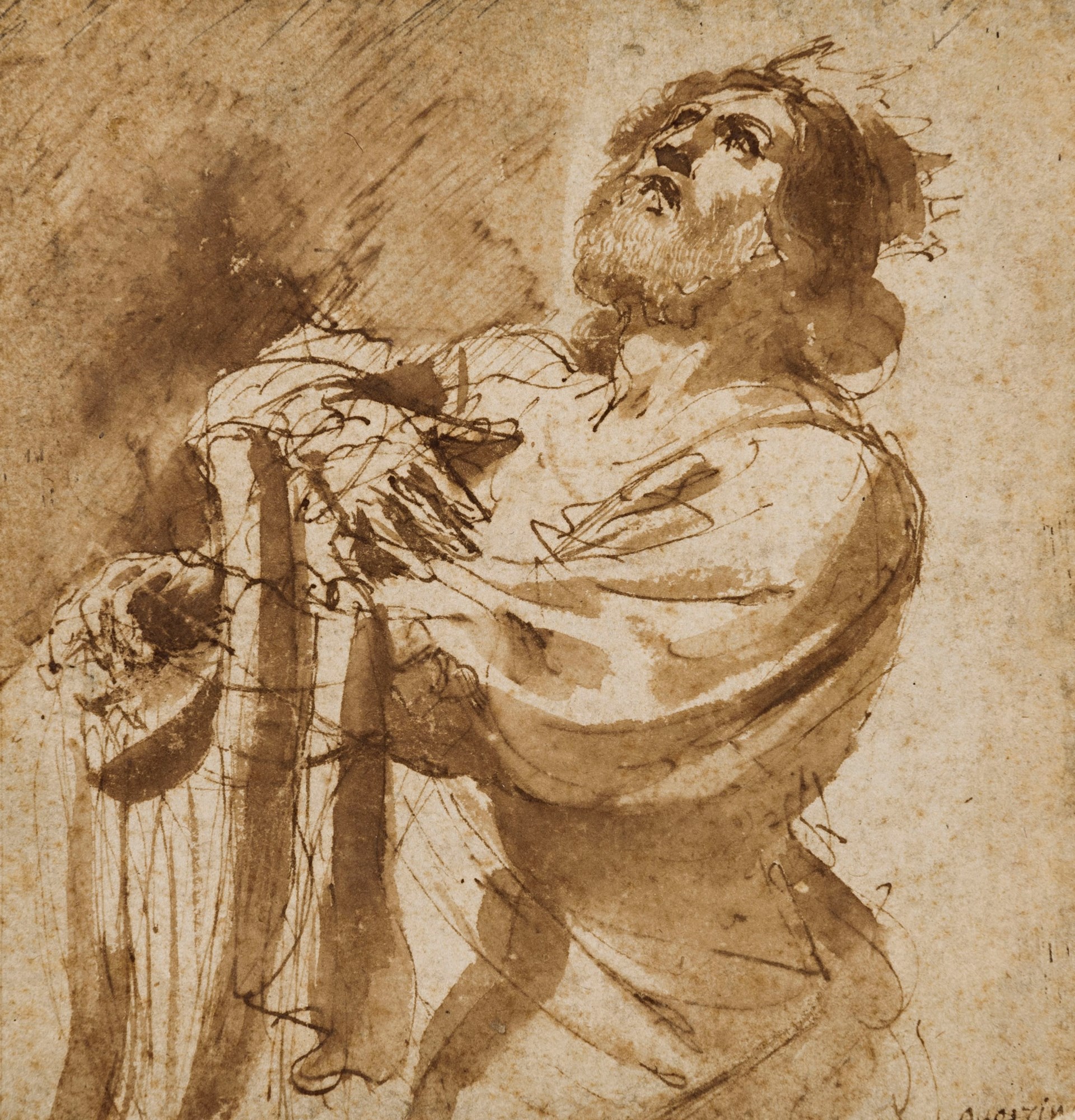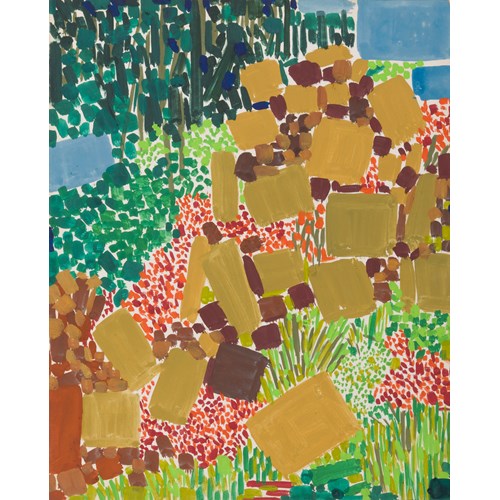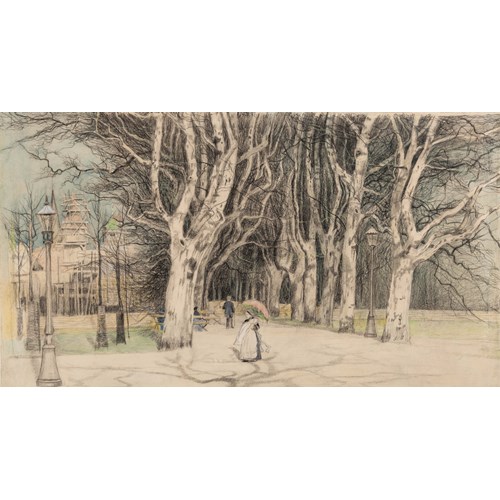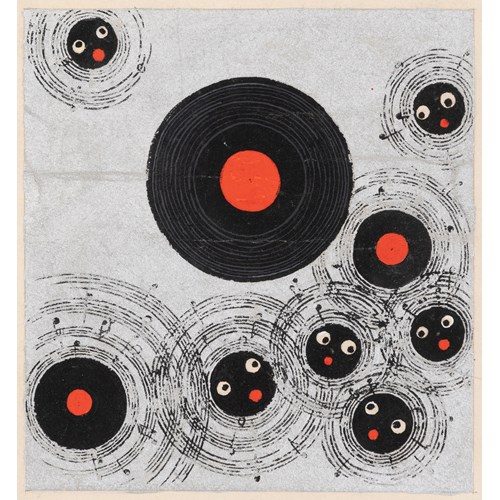Marketplace
King David with his Harp
The Biblical figure of David occurs in Guercino’s painted oeuvre throughout his career, sometimes accompanied by a musical instrument, usually the harp (or lyre) which he played with great skill. This newly-discovered drawing can be closely related to two other pen and wash studies of the crowned David with his harp, one in the British Museum in London and the other formerly at Holkham Hall in Norfolk and now in the Goldman collection in Chicago. However, no three-quarter length painting of this particular subject is recorded in Guercino’s account book, the Libro dei Conti, nor is one mentioned by Cesare Malvasia in his biography of the artist.
Nicholas Turner has recently suggested that both the British Museum and Goldman drawings, and by extension the present sheet, may be first ideas for Guercino’s painting of King David Rending his Garments of 1637, formerly in the collection of the Bob Jones University Museum in Greenville, South Carolina, and lately sold at auction in France. The canvas is listed in the Libro dei Conti under 14 July 1637, when the artist was paid fifty ducats by a Monsignor Gorri, Vice Legate of Bologna, for ‘una mezza figura di un David Profeta fatto in atto di rompersi gli habiti propri.’ A red chalk drawing by an artist in Guercino’s circle, now in the collection of the Albertina in Vienna, depicts the same subject as the painting of King David Rending his Garments of 1637, albeit in reverse, and is likely to be a copy of a lost autograph drawing for the picture.
The existence of three other half-length drawings of King David by Guercino, each of which show the figure looking upwards but not in the act of tearing his vestments, has led Turner to suggest that Guercino may have originally planned the painted composition quite differently, with David leaning on his harp. As Turner hypothesizes, ‘It is likely that Monsignore Gorri was offered a more conventional composition of King David, half-length, as attested by two original drawings [ie. the British Museum and Goldman drawings], both datable on stylistic grounds to the mid-1630s…which show him half-length, looking heavenwards.’ Of the other two related drawings of this subject, the present sheet is closest in composition to the study in the British Museum, notably in the angle of David’s head and the position of his right arm and hand.
Two later pen and ink drawings by Guercino of King David accompanied by his harp – one in the Berkeley Art Museum and Pacific Film Archive at the University of California and the other in a private collection - as well as a black chalk study of the same subject formerly in the Mariette collection and now in the Louvre, show the Biblical monarch as a somewhat older and more pensive figure. All three drawings, which may be dated to around 1650, lack the overt emotion evident in the present sheet and its related studies, as well as the 1637 canvas, and are likely to be related to a later painting of King David, albeit without his harp, commissioned from the artist in 1651 and today on loan from the Rothschild Collection to Waddeson Manor in Buckinghamshire.
A native of Alsace, the art historian and museum curator Hans Haug (1890-1965) served as director of both the Musée des Beaux-Arts and the Hohenlohemuseum (later renamed the Musée des Arts Décoratifs) in Strasbourg, from 1919 until his retirement in 1963.
Nicholas Turner has recently suggested that both the British Museum and Goldman drawings, and by extension the present sheet, may be first ideas for Guercino’s painting of King David Rending his Garments of 1637, formerly in the collection of the Bob Jones University Museum in Greenville, South Carolina, and lately sold at auction in France. The canvas is listed in the Libro dei Conti under 14 July 1637, when the artist was paid fifty ducats by a Monsignor Gorri, Vice Legate of Bologna, for ‘una mezza figura di un David Profeta fatto in atto di rompersi gli habiti propri.’ A red chalk drawing by an artist in Guercino’s circle, now in the collection of the Albertina in Vienna, depicts the same subject as the painting of King David Rending his Garments of 1637, albeit in reverse, and is likely to be a copy of a lost autograph drawing for the picture.
The existence of three other half-length drawings of King David by Guercino, each of which show the figure looking upwards but not in the act of tearing his vestments, has led Turner to suggest that Guercino may have originally planned the painted composition quite differently, with David leaning on his harp. As Turner hypothesizes, ‘It is likely that Monsignore Gorri was offered a more conventional composition of King David, half-length, as attested by two original drawings [ie. the British Museum and Goldman drawings], both datable on stylistic grounds to the mid-1630s…which show him half-length, looking heavenwards.’ Of the other two related drawings of this subject, the present sheet is closest in composition to the study in the British Museum, notably in the angle of David’s head and the position of his right arm and hand.
Two later pen and ink drawings by Guercino of King David accompanied by his harp – one in the Berkeley Art Museum and Pacific Film Archive at the University of California and the other in a private collection - as well as a black chalk study of the same subject formerly in the Mariette collection and now in the Louvre, show the Biblical monarch as a somewhat older and more pensive figure. All three drawings, which may be dated to around 1650, lack the overt emotion evident in the present sheet and its related studies, as well as the 1637 canvas, and are likely to be related to a later painting of King David, albeit without his harp, commissioned from the artist in 1651 and today on loan from the Rothschild Collection to Waddeson Manor in Buckinghamshire.
A native of Alsace, the art historian and museum curator Hans Haug (1890-1965) served as director of both the Musée des Beaux-Arts and the Hohenlohemuseum (later renamed the Musée des Arts Décoratifs) in Strasbourg, from 1919 until his retirement in 1963.
Provenance: Hans Haug, Strasbourg.
Plus d'œuvres d'art de la Galerie









